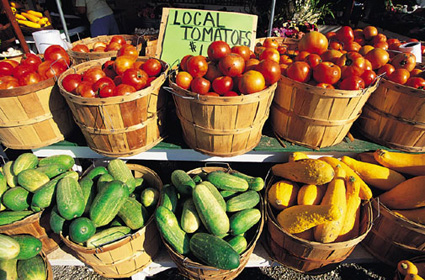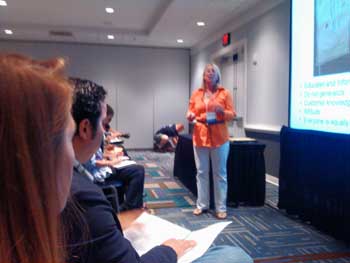Aquaponics: Tips to Selling your Produce at Farmers Markets

Good Signage helps promote your product with clear pricing and unique produce commanding a higher price.
Although many people get into aquaponics for the fun of growing fish and plants together, they soon realize the potential that aquaponics could offer them.
“Going Commercial” is the hot topic on Aquaponics Forums as people consider the possibility of selling their surplus produce or even building a larger more commercial system to sell their fresh clean food.
The plunge to go head first into a business venture could prove disastrous if people don’t research their business model properly.
Anne Forsthoefel spoke recently at the Aquaponics Conference in Orlando Florida. She offered attendees some valuable tips on selling your surplus at Farmers Markets.
Portland Markets
The Portland markets began 20 years ago with 13 farms selling their produce and now its grown to 167 vendors with $10 million in sales turnover and over 16,000 visitors looking for fresh locally grown produce.
Although by no means complete or applicable only to Aquaponics, Anne’s tips make a lot of common sense in building a solid relationship within your community.
Here are her tips of marketing your produce successfully.
Tips on Selling your Produce
-
Know your Buyers by name
It might sound too simple, but remembering your buyers first name and greeting them with a “Hi John!” when they approach your stall pays dividends and build brand loyalty and friendship. You will forever have an advantage that the big food chains with their depersonalized stores can never compete with. Anne Forsthoefel says that in the 21st century “Community and relationships are what people are starving for.” Take advantage of that need.
-
Train your Buyers
Not everyone understands your produce or how long it took to grow or if plants grown in aquaponics have a fish smell. Explain the vagaries of local food grown within your community and be prepared to extoll the virtues of why that tomato variety tastes as good as it does because of the local climate. Anne also says that people love to try something that is rare. Scarcity is always at a premium price so explain the variety of lettuce you have grown. That Japanese Mizuna Lettuce you have on sale may need to be explained to people why its so good for their diet, tastes like a mustard green and the health benefits it contains.
-
Everyone has an Opinion
Smile and be respectful to people that come to your booth. Most people already have an opinion so don’t get into an argument over details. As Anne says, “This is retail folks. If you don’t like people – then don’t man your booth!” Find someone else with a pleasant personality to do that job for you. Joel Salatin an American farmer recently said the same thing. Not everyone is suited to manning a stall and being pleasant to people asking the same dumb questions. Know when the job is beyond you.
-
Beautiful Signage
Believe it or not, people form an immediate impression when they look at your booth or stall for the first time. First impressions count and well made signage proclaiming your name and goods – hanging over your head evokes your image, your style, your brand. Its your business card. It draws people into your booth to investigate further. This doesn’t mean cheap however. A rough ink scrawl on a piece of old cardboard doesn’t evoke quality – or style. Think carefully about your brand image and if you want to get the best price for your produce, spend a little time and effort crafting signage that evokes the mood you wish to portray.
-
Offer Samples
One of the best ways to get people to flock to your stall is to offer them a free sample and enable them to do the taste test. People are naturally curious and anything grown “aquaponically” will bring out the curious eager to do their own research. Small bit sized pieces of cooked fish on skewers will attract a lot of people.
-
Attention to Detail
Anne recommends that you price every sale item and make it easy to see. Be prepared to explain your pricing structure to your buyer.
“Be fair and be prepared to justify your price.” she said.
When it comes to organizing the shape and look of your stall, Anne has a particular point of view as to what works and what puts people off. She is not in favour of booths that are “U” shaped or feature a tunnel look that is meant to incite people to wander into and look around. People want a point of departure and don’t like to hemmed in. A shopfront table between you and the buyer seems to be the best format that continually works well for marketing your produce. -
Community Relationships
“The history of selling food has traditionally been face to face.” says Anne. “Its only recently that bio-business has depersonalized it.” Working with people and giving something back is what builds stronger localized communities.
“Those who succeed are the people who believe in the movement of creating a resilient food system.”
“Not doing it just for themselves but for something greater.” she says. “But you need to work within your local government and get political.”
“If we encouraged local food markets within the USA – everyone would be employed.”









Sounds like great and usable advise to me.